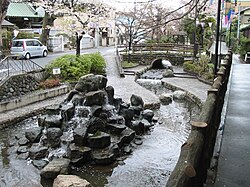Edogawa, Tokyo
This article needs additional citations for verification. (August 2018) |
Edogawa
江戸川区 | |
|---|---|
Special ward | |
| Edogawa City[1] | |
 Furukawa Waterside Park in Edogawa | |
 Flag  Emblem | |
 Location of Edogawa in Tokyo Metropolis | |
 Edogawa Location in Japan | |
| Coordinates: 35°42′N 139°53′E / 35.700°N 139.883°ECoordinates: 35°42′N 139°53′E / 35.700°N 139.883°E | |
| Country | Japan |
| Region | Kantō |
| Prefecture | Tokyo Metropolis |
| First official recorded | 721 AD |
| As City of Tokyo | October 1, 1932 |
| As Special ward of Tokyo | July 1, 1943 |
| Government | |
| • Mayor | Takeshi Saitō (since April 2019) |
| Area | |
| • Total | 49.90 km2 (19.27 sq mi) |
| Population (January 1, 2020) | |
| • Total | 695,797 |
| • Density | 13,680/km2 (35,400/sq mi) |
| Time zone | UTC+09:00 (JST) |
| Website | www |
| Symbols | |
| Flower | Rhododendron |
| Tree | Cinnamonum camphora |

Edogawa (江戸川区, Edogawa-ku) is one of 23 special wards located in Tokyo Metropolis, Japan. It takes its name from the Edo River that runs from north to south along the eastern edge of the ward. In English, it uses the name Edogawa City.
The easternmost of the wards, it shares boundaries with the cities of Urayasu and Ichikawa in Chiba Prefecture (to the east) and with the wards of Katsushika (to the north), Sumida and Kōtō (to the west). It meets the city of Matsudo in Chiba at a point.
Edogawa has a sister-city relationship with Gosford, New South Wales, Australia. Domestically, it has friendship ties with the cities of Azumino in Nagano Prefecture and Tsuruoka in Yamagata Prefecture.
As of January 1, 2020, the ward has an estimated population of 695,797, and a population density of 13,925 persons per km².[citation needed] The total area is 49.90 km².
History[]
This section needs expansion. You can help by . (May 2021) |
The ward was founded in 1937 with the merger of seven towns and villages in : the towns of Koiwa and Komatsugawa, and the villages of Kasai, Matsue, Mizue, Shinozaki and Shikamoto.
Demographics[]
Edogawa is notable for its large Indian population. There were 3,758 Indians living in the ward as of January 2018, centered in the neighborhood. Around 30% of Indians in Tokyo, and 10% of all Indians in Japan, live in Edogawa.[2]
Districts and neighborhoods[]
|
|
|
Sites[]
- Edogawa Boat Race Course
- Edogawa Stadium
- Kasai Seaside Park
Notable people[]
- Seiya Ando, basketball player
- Keita Ono, darts player
- Akiko Hinagata, actress
- Daisuke Matsuzaka, baseball player (played for Seibu Lions and currently with the Boston Red Sox)
- Hayato Aoki, baseball player
- Fuka Nagano, soccer player
- Ira Ishida, novelist
- Kazuhide Uekusa, former economics professor at Waseda University convicted of sex offences
- Kazuya Kamenashi, J-pop idol, singer, actor, television host (member of KAT-TUN)
- Kazuyoshi Nakamura, actor
- Keizō Kanie, actor
- Kenta Suga, actor
- Kreva, rapper
- Maki Goto, singer (Morning Musume)
- Masahiro Yanagida, professional volleyball player
- Norikazu Otsuka, announcer
- Romi Park, actress and voice actress
- Takamasa Suga, actor
- Takeshi Morishima, professional wrestler
- Tochinishiki Kiyotaka, 44th yokozuna in sumo
- Tomochika Tsuboi, baseball player
- Uno Misako, is a Tarento, artist, actress, essayist and talent agent best known as a lead vocalist and dancer of the Co-ed performing arts group AAA.
- Yasuo Namekawa,is a Korean–Japanese singer and television personality. He was the vocalist and oldest member of the South Korean hip-hop group M.I.B
- Yoshiko Tamura, wrestler
- , vocalist and guitarist for Base Ball Bear
- Yogendra Puranik, India-born politician
Education[]
Public elementary and junior high schools are operated by the .
Public high schools are operated by the Tokyo Metropolitan Government Board of Education.
Private High Schools:
- Edogawa Girls' High School[10]
International schools:
Universities
Transportation[]
Rail[]
- ■ East Japan Railway Company
- ■ Chūō-Sōbu Line
- – Hirai – Shin-Koiwa(Shin-Koiwa Station is in Katsushika, Tokyo) – Koiwa –
- ■ Keiyō Line
- – Kasairinkai-Kōen –
- ■ Toei
- ○ Toei Shinjuku Line
- – Higashi-Ōjima – Funabori – Ichinoe – Mizue – Shinozaki –
- ■ Tokyo Metro
- ○ Tozai Line
- – Nishi-Kasai – Kasai –
Highway[]
- Shuto Expressway
- C2 Central Loop
- No.7 Komatsugawa Route
- B Bayshore Route
See also[]
References[]
- ^ Multilingual 江戸川区公式ホームページ. City.edogawa.tokyo.jp. Archived from the original on November 19, 2017. Retrieved August 1, 2018.
- ^ "Tokyo's Nishikasai a second home for Indians in Japan". The Statesman. May 20, 2018. Retrieved March 19, 2021.
- ^ "Archived copy". Archived from the original on November 14, 2007. Retrieved October 30, 2007.CS1 maint: archived copy as title (link)
- ^ 東京都立葛西工業高等学校 – Tokyo Metropolitan Kasai Technical High School. Kasaikogyo-h.metro.tokyo.jp. Retrieved August 1, 2018.
- ^ 東京都立葛西南高等学校. Kasaiminami-h.metro.tokyo.jp. Retrieved August 1, 2018.
- ^ "Archived copy". Archived from the original on October 21, 2007. Retrieved October 30, 2007.CS1 maint: archived copy as title (link)
- ^ "Archived copy". Archived from the original on November 3, 2007. Retrieved October 30, 2007.CS1 maint: archived copy as title (link)
- ^ "Archived copy". Archived from the original on October 30, 2007. Retrieved October 30, 2007.CS1 maint: archived copy as title (link)
- ^ "Archived copy". Archived from the original on November 14, 2007. Retrieved October 30, 2007.CS1 maint: archived copy as title (link)
- ^ 江戸川女子中学校・高等学校. Edojo.jp. Retrieved August 1, 2018.
External links[]
| Wikimedia Commons has media related to Edogawa, Tokyo. |
- Edogawa City Official Website (in Japanese)
- Edogawa, Tokyo
- Wards of Tokyo

